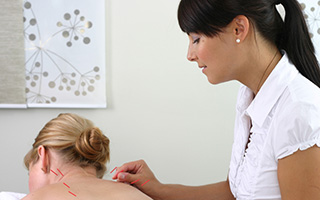Holistic Health & Alternative Medicine Schools
Alternative medicine schools give aspiring healers like you the chance to learn natural, holistic, and time-honored approaches to health care.
Can you visualize being able to carry out treatments that take a patient's whole mind, body, and spirit into account? Some of them go back thousands of years. And they've become increasingly popular and more refined as people seek ways to prevent or alleviate their health problems without relying solely on what mainstream medicine offers.
That's why earning an alternative medicine degree, diploma, or certificate can open up enticing career opportunities. It enables you to enter a field in which helping people is the top priority. And it also creates the potential of working with other like-minded healers or even becoming an independent practitioner in an area like naturopathy, therapeutic massage, or traditional Chinese medicine.
So make your next move right now. Discover the alternative and holistic health schools in your region by typing in your zip code!
3 Useful Things to Understand About Going into Alternative Medicine
3 Useful Things to Understand About Going into Alternative Medicine
 Anyone considering a career in this field certainly has a lot of fascinating stuff to think about. After all, the expansion of alternative health care in America is creating new questions alongside many new possibilities. And the market for this type of care only seems to be getting stronger. Look at a few relatively recent statistics about alternative medicine:
Anyone considering a career in this field certainly has a lot of fascinating stuff to think about. After all, the expansion of alternative health care in America is creating new questions alongside many new possibilities. And the market for this type of care only seems to be getting stronger. Look at a few relatively recent statistics about alternative medicine:
- According to the National Center for Complementary and Integrative Health (NCCIH), about 1.3 percent of adults in the U.S. received some kind of naturopathic treatment in 2022.
- A survey from Statista reported that 55 percent of American adults used some type of alternative medicine in 2021.
- The same survey from Statista also found that, roughly six percent of American adults used homeopathy to treat health problems.
Clearly, the stats are compelling. But as you think about pursuing a health and wellness degree or other type of credential from one of America's alternative or natural medicine schools, it helps to consider these aspects:
1. Distinctions in Terminology
Some people use a few different terms interchangeably to describe this overall field. However, it's worth taking a moment to understand what each one really means. For example, notice the differences between the following popular terms:
- Alternative medicine—Any set of health or medical treatments that are used instead of standard approaches from mainstream medicine
- Complementary medicine—When both standard and alternative treatments are used together, but usually by different providers in separate health facilities
- Integrative medicine—When the same health care provider uses mainstream treatments as well as some alternative approaches that are backed by reliable scientific evidence supporting their safety and effectiveness
- Holistic medicine—Health care approaches, often using at least some alternative methods, that aim to treat a person's mind and spirit in addition to his or her physical body
- Naturopathy or natural medicine—A health care philosophy in which the aim is to use the most natural and least invasive treatments possible (whether from mainstream or alternative medicine) while supporting the human body's own ability to heal itself and maintain wellness
2. What You Might Learn About
Depending on the alternative medicine program you choose, you'll receive a great opportunity to learn about several aspects of this field in a comprehensive way. For instance, it's easy to find programs that cover Asian healing systems in addition to subjects like nutrition and psychological health. Many even go over areas such as massage therapy, aromatherapy, stress management, and herbology (i.e., using herbs and other plant-based treatments). Plus, some programs cover especially fascinating areas like:
- Acupuncture—One of traditional Chinese medicine's main forms of treatment, which often involves using thin metallic needles to stimulate different points on a patient's body
- Ayurvedic medicine—A health and wellness system from India that is over 3,000 years old and involves using special diets, herbal treatments, and other distinctive methods
- Biofeedback—A treatment approach in which patients are trained to use their minds to voluntarily control bodily functions that normally happen automatically (such as heart rate, blood pressure, and muscle tension)
- Homeopathy—A treatment system developed over 200 years ago based on two core ideas: (1) that an illness might be cured by ingesting a substance known to cause similar symptoms as those of the illness being treated and (2) that the lower the dose of that substance or medication, the better its effectiveness might be
3. Requirements for Practicing Natural or Alternative Medicine
 In the United States, no national standard exists for certifying natural, alternative, or holistic health practitioners. Instead, it is up to individual state and municipal governments to decide whether or not to regulate people in this sector. As a result, some regions have credentialing requirements such as licensure, certification, or registration whereas others do not.
In the United States, no national standard exists for certifying natural, alternative, or holistic health practitioners. Instead, it is up to individual state and municipal governments to decide whether or not to regulate people in this sector. As a result, some regions have credentialing requirements such as licensure, certification, or registration whereas others do not.
In locations that do have regulations, the requirements can vary substantially. But they often include the need to graduate from a recognized school for complementary or alternative medicine and pass a written and/or practical exam in order to earn official certification from a national organization. A few examples of prominent certifying bodies include:
- National Certification Board for Therapeutic Massage and Bodywork (NCBTMB)
- North American Board of Naturopathic Examiners (NABNE)
- Council for Homeopathic Certification (CHC)
- National Certification Commission for Acupuncture and Oriental Medicine (NCCAOM)
How to Move Forward
Your education in holistic or natural health can begin very soon. In fact, many alternative medicine schools are set up to help students get started with little or no waiting. Why not find one in your region right now by searching with your zip code?
